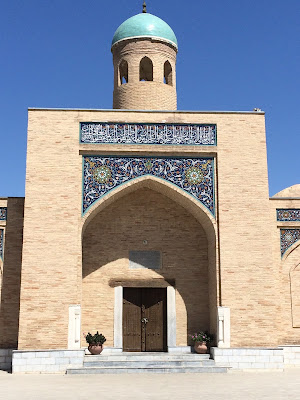We left Samarkand
for our yurt camp at 8.00am and then stopped after four hours at Nurata to see
its famous shrine and Marinka fish!! The road through the semi arid desert
stretched for miles.... totally boring scenery. The coach was new and comfortable,
the driver good; so it was bearable.
Nurata was
founded as the ancient town Nur in 327 BC by Alexander the
Great. The remains of his military fortress in the south of the town
are still to be seen today and the water supply system that Alexander had
installed is still partially used. The small town Nurata is located in the foothills
of Nuratau Mountains, stretching out hundreds kilometres from Jizzakh and
Barren Steppe to Navoi and Kyzylkum desert. It is the administrative and
cultural centre of mountain area in Navoi region and is located almost 200 km
from Samarkand.
The town is also
famous as a Muslim pilgrimage place. Muhammad Narshakhi wrote about the history
of Bukhara in 943 provides information
about the settlement Nur. Narshakhi wrote” many people, who are buried there,
have seen Prophet Muhammad”.
During the 10th century pilgrims from Bukhara and other places came to the holy
graves situated next to the town fortifications and mosques.
Chashma is a
place of pilgrimage of believers and one of the most significant religious centres
of Islam in the region. The complex of religious constructions “Chasma” (Tadjik
word for spring) includes the spring, a well, mosque “Djuma” and khamom
(bathhouse). The round Djuma mosque was constructed above the spring and has 40
columns. The dome is 16 meters in diameter is one of the largest in the Central
Asia. On the south-east part of the complex is a Nur-ata cemetery with the
burial place of the saintly person.
We entered the
Chashma complex at high noon with the sun blazing down on us. Security was present
but lax. The senior person, in the black round cap , above, supervised the older guy who
was writing. Our tickets were checked and the details written down of each
individual. What do they do with this data, I wonder? He looked at me rather
suspiciously as I took photos of the guy writing our details.
It is worth commenting on the technical / scientific
data about this spring: the water temperature is always 19.5º C. Water
composition includes 15 microelements as well as gold, silver, bromide and
iodine which impart unique healing properties to it. In addition the spring is
the home for thousands of scale- less fish – Marinka. This fish as well as the
spring is considered as sacred and people do not eat it.
The fortress
consisted of several parts, with Shahristan (the inner town) around 500 sq
metres in size, which was surrounded by a large wall and towers. The
construction of a fortress at Nurata had a definite purpose, as the town was
set in a strategic place at the border between an agricultural area and a wild
steppe. This area is mentioned in several historical chronicles as an important
strategic area convenient for gathering an army before attacking neighbouring
lands and as a place of refuge for rebels and outcasts. The climb to the top of
the ruined fortress was one I had to make to see for myself one of Alexander the
Great’s fort and the view from above.
The construction
of Kariz, a unique underground water-pipeline system near Nurata, is also
connected with the name of the Alexander the Great. Kariz is an ancient
water-pipe laid from the source of the spring water to a place where it could
be used. Its length could reach several kilometres. Interconnected wells that
were dug out in several meters apart from each other, were used for the
cleaning the pipeline system. Today the process of reviving these old pipeline
systems is taking place. Parts of the pipeline systems near Nurata were
restored and being used by local people.

We reached Ayederkul
Lake, a completely man made water body created in 1996, at around 3.15 pm. Amazing
sight right there is the desert. This huge lake. Horses were drinking at its
far end. The majority of the group went into the water for a relaxing swim.
I spent my time
walking around and then we left for the yurt camp. Hope you read that travel blog:
“A
Yurt experience in the south-eastern Kyzylkum desert of Uzbekistan”.
Text and photographs copyright of the author. No part of this article or photographs maybe transmitted or reproduced by any means, electronic, mechanical, photocopying or otherwise, without written permission. Do contact the author on email -- helpthesun@gmail.com





























No comments:
Post a Comment
Text and photographs are copyright of the author. No part of any article or photographs maybe transmitted or reproduced by any means, electronic, mechanical, photocopying or otherwise, without written permission. Do contact the author on email -- helpthesun@gmail.com